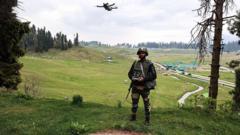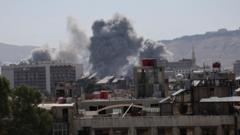### Summary: The latest round of hostilities between India and Pakistan has introduced drones as key players in their conflict, with both nations claiming to shoot down each other's unmanned aerial vehicles. This new technological phase raises concerns over potential escalation in an already tense region.
### Title: The Dawn of Drone Warfare: India and Pakistan's High-Stakes Conflict

### Title: The Dawn of Drone Warfare: India and Pakistan's High-Stakes Conflict
### Description: In a groundbreaking escalation, India and Pakistan engage in drone warfare, marking a risky new chapter in their long-standing rivalry.
In a significant development for South Asia's security landscape, India and Pakistan have entered the world's first drone war between nuclear-armed neighbors. Reports surfaced Thursday as India accused Pakistan of launching a series of drone and missile attacks on several military bases within Indian-administered Kashmir. Pakistan, on the other hand, refuted these claims, asserting that it had successfully intercepted 25 Indian drones in recent hours, leading to an unprecedented exchange of unmanned assaults.
Authorities and analysts express grave concerns about this shift in warfare method, suggesting that using drones could redefine the strategic landscape of the long-standing Indo-Pak rivalry. Soaring tensions have drawn calls for restraint from international entities like the United States, as both nations exchange aerial barrages amidst the volatility. Jahara Matisek, a scholar from the US Naval War College, emphasized the significant role drones could play, stating that superior drone capabilities may dictate the terms of this new conflict.
Casualty figures indicate the humanitarian toll on both sides, with Pakistan reporting 36 fatalities and around 57 injuries in its territory due to Indian cross-border fire, while India’s military claims to have documented at least 16 civilian deaths due to retaliatory shelling from Pakistan. India asserts its missile attacks were a direct response to a militant incident in Pahalgam last month, which Pakistan has denied involvement in.
As the tactical landscape evolves, India's drone arsenal is largely comprised of advanced Israeli models designed for reconnaissance and precision strikes, including the IAI Searcher and Heron systems. Recently, India also commissioned a $4 billion acquisition of 31 MQ-9B Predator drones, which signifies a pivotal enhancement in its aerial capabilities. In contrast, Pakistan boasts a diverse fleet of over a thousand drones, integrating both domestic and international systems to bolster its military response.
Military analysts observe that, unlike the high-stakes aerial campaigns witnessed in the Russia-Ukraine war, the drone exchanges between India and Pakistan are yet defined by caution, utilizing unmanned systems as tactical options rather than full-scale war engines. Manoj Joshi, an Indian defense commentator, indicated this current phase could be a precursor to broader conflict, yet remain more restrained by their nature.
Experts note that drone technology introduces both opportunities and risks, lowering thresholds for military action while simultaneously amplifying the potential for escalation. In a tense environment, the loss of a single drone could trigger significant backlash, echoing the precarious balance both nations must navigate as they venture into this new domain of warfare.
As the dust settles on this drone warfare evolution, analysts remain divided on what the future holds—whether this represents a temporary skirmish or a signal for a larger, more comprehensive military engagement, with both capabilities and stakes higher than ever before amid a fraught geopolitical landscape.
Authorities and analysts express grave concerns about this shift in warfare method, suggesting that using drones could redefine the strategic landscape of the long-standing Indo-Pak rivalry. Soaring tensions have drawn calls for restraint from international entities like the United States, as both nations exchange aerial barrages amidst the volatility. Jahara Matisek, a scholar from the US Naval War College, emphasized the significant role drones could play, stating that superior drone capabilities may dictate the terms of this new conflict.
Casualty figures indicate the humanitarian toll on both sides, with Pakistan reporting 36 fatalities and around 57 injuries in its territory due to Indian cross-border fire, while India’s military claims to have documented at least 16 civilian deaths due to retaliatory shelling from Pakistan. India asserts its missile attacks were a direct response to a militant incident in Pahalgam last month, which Pakistan has denied involvement in.
As the tactical landscape evolves, India's drone arsenal is largely comprised of advanced Israeli models designed for reconnaissance and precision strikes, including the IAI Searcher and Heron systems. Recently, India also commissioned a $4 billion acquisition of 31 MQ-9B Predator drones, which signifies a pivotal enhancement in its aerial capabilities. In contrast, Pakistan boasts a diverse fleet of over a thousand drones, integrating both domestic and international systems to bolster its military response.
Military analysts observe that, unlike the high-stakes aerial campaigns witnessed in the Russia-Ukraine war, the drone exchanges between India and Pakistan are yet defined by caution, utilizing unmanned systems as tactical options rather than full-scale war engines. Manoj Joshi, an Indian defense commentator, indicated this current phase could be a precursor to broader conflict, yet remain more restrained by their nature.
Experts note that drone technology introduces both opportunities and risks, lowering thresholds for military action while simultaneously amplifying the potential for escalation. In a tense environment, the loss of a single drone could trigger significant backlash, echoing the precarious balance both nations must navigate as they venture into this new domain of warfare.
As the dust settles on this drone warfare evolution, analysts remain divided on what the future holds—whether this represents a temporary skirmish or a signal for a larger, more comprehensive military engagement, with both capabilities and stakes higher than ever before amid a fraught geopolitical landscape.






















